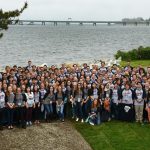The Blavatnik Family Foundation and the New York Academy of Sciences today announced the 2017 Laureates of the Blavatnik National Awards for Young Scientists. Starting with a pool of 308 nominees – the most promising scientific researchers aged 42 years and younger nominated by America’s top academic and research institutions – a distinguished jury first narrowed their selections to 30 Finalists, and then to three outstanding Laureates, one each from the disciplines of Life Sciences, Chemistry and Physical Sciences & Engineering. Each Laureate will receive $250,000 – the largest unrestricted award of its kind for early career scientists and engineers. This year’s Blavatnik National Laureates are:
Feng Zhang, PhD, Core Member, Broad Institute of MIT and Harvard; Associate Professor of Brain and Cognitive Sciences and Biomedical Engineering, MIT; Robertson Investigator, New York Stem Cell Foundation; James and Patricia Poitras ’63 Professor in Neuroscience, McGovern Institute for Brain Research at MIT. Dr. Zhang is being recognized for his role in developing the CRISPR-Cas9 gene-editing system and demonstrating pioneering uses in mammalian cells, and for his development of revolutionary technologies in neuroscience.
Melanie S. Sanford, PhD, Moses Gomberg Distinguished University Professor and Arthur F. Thurnau Professor of Chemistry, University of Michigan. Dr. Sanford is being celebrated for developing simpler chemical approaches – with less environmental impact – to the synthesis of molecules that have applications ranging from carbon dioxide recycling to drug discovery.
Yi Cui, PhD, Professor of Materials Science and Engineering, Photon Science and Chemistry, Stanford University and SLAC National Accelerator Laboratory. Dr. Cui is being honored for his technological innovations in the use of nanomaterials for environmental protection and the development of sustainable energy sources.
“The work of these three brilliant Laureates demonstrates the exceptional science being performed at America’s premiere research institutions and the discoveries that will make the lives of future generations immeasurably better,” said Len Blavatnik, Founder and Chairman of Access Industries, head of the Blavatnik Family Foundation, and an Academy Board Governor.
“Each of our 2017 National Laureates is shifting paradigms in areas that profoundly affect the way we tackle the health of our population and our planet — improved ways to store energy, “greener” drug and fuel production, and novel tools to correct disease-causing genetic mutations,” said Ellis Rubinstein, President and CEO of the Academy and Chair of the Awards’ Scientific Advisory Council. “Recognition programs like the Blavatnik Awards provide incentives and resources for rising stars, and help them to continue their important work. We look forward to learning where their innovations and future discoveries will take us in the years ahead.”
The annual Blavatnik Awards, established in 2007 by the Blavatnik Family Foundation and administered by the New York Academy of Sciences, recognize exceptional young researchers who will drive the next generation of innovation by answering today’s most complex and intriguing scientific questions.




